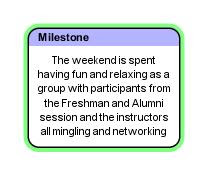So, if you remember my last post I suggested we need to prepare our mental muscles for the hard labour of TP and one of the exercises I suggested was thinking backwards. Now, this is not the TP's transition tree, which is also constructed backwards. It is also not the usual managerial focus of let's plan with the end in mind, which usually ends up being a forward construciton exercise. It's a free formed process that starts at the end and moves forward by imagining a probable route.
Here I will share the results of my recent use of this process. I have volunteered to make the 2016 TOC Odyssey happen. It will be in Jaffa during the first weeks of April, 2016 (Save the dates - April 3-7 for the Freshman session, April 10-13 for the Alumni, dates are currently estimates). It is my wish to make this session a big success - fun, enriching and enlightning for everyone. To make this happen I am starting out with thinking backwards (as suggested in Purple Curve Effect by Jeff Kinsey - see my book review here) to see what I can learn from it,
First of - my goal, the end result:
Here I will share the results of my recent use of this process. I have volunteered to make the 2016 TOC Odyssey happen. It will be in Jaffa during the first weeks of April, 2016 (Save the dates - April 3-7 for the Freshman session, April 10-13 for the Alumni, dates are currently estimates). It is my wish to make this session a big success - fun, enriching and enlightning for everyone. To make this happen I am starting out with thinking backwards (as suggested in Purple Curve Effect by Jeff Kinsey - see my book review here) to see what I can learn from it,
First of - my goal, the end result:
Can I imagine how reaching this goal would feel? yes, I can, right down to that pleased-embarrased feeling as everybody claps. This is a big issue, a lot of times I start this exercise and realise I have no clue what the end result looks and feels like. Just try this out right now - is there a change you would like to do in your life? lose some weight? go to bed earlier? spend more time with someone? learn something? OK, that's great. Now - can you imagine vividly, in your mind's eyes, the end point scene? what will you wear, say, feel, do?
So, I can see this goal coming to life. Great! Now what? Well, what could have or should have happened before that to make it possible? What was the step before the goal? Here is my answer:
Can I imagine achieving this milestone? again I can, I can even hear Alan Barnard's distinct accent as he tells me how much he enjoyed leading the session. Great! Now ask again - How did that happpen? What could have happened before that? Basically we are looking for possible causes to create the wanted effect.
And so I get on a backward roll:
 |
| All graphics were done using Flying Logic |
So far, so good. This is where I got a bit sidetracked, as this is the stage where several predessessors converge. It is also where I move from reaping the future results to defining the work that needs to be done in order to make it happen. So this exercise seems to have been quite un-productive so far, doesn't it? Well, that's not true. This part has made it clear that this is a very just cause, quite worthy of my investment. Now I am really motivated to make the 2016 Odyssey one to be remembered!
Next step - to take the next leg of down the future memory lane - what did I do to make it happen? Check out what happened here!











